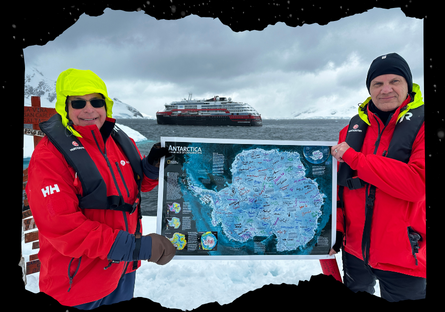
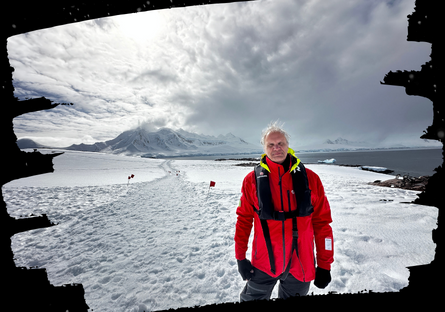
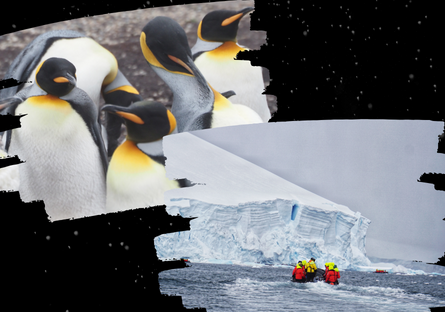
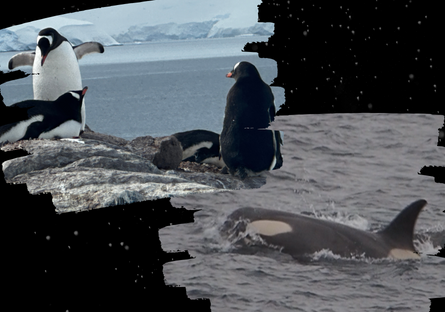
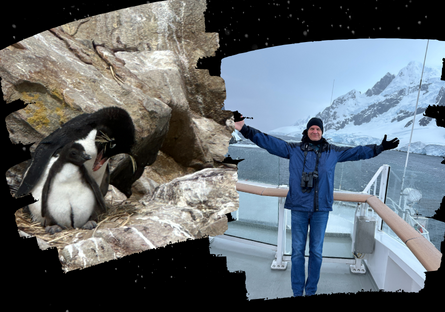
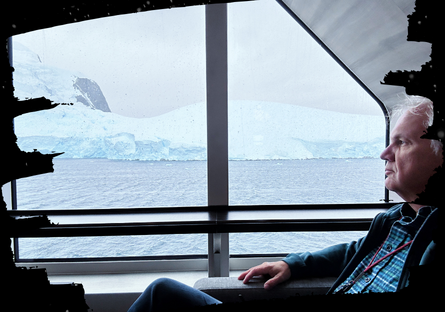
EMCC Professor Realizes Lifelong Dream of Visiting Antarctica
Tourism has been steadily growing in Antarctica. Still, only about 70,000 people on the entire planet can say they stepped foot on the frozen continent last year. Estrella Mountain Community College (EMCC) Professor Eric Eckert is one of them.
Because Antarctica’s tourism season starts in October and ends in April, the Southern Hemisphere’s summer, the only window of opportunity for EMCC’s Computer Science professor, who also teaches at Arizona State University (ASU), was over the winter break. After flying to Miami and then to Buenos Aires, where he spent a couple of days sightseeing, he took a flight to Ushuaia, the southernmost city in the world on the tip of South America. That’s where he met his fellow shipmates with whom he would spend the next two weeks aboard the MS Roald Amundsen.
“It was an eclectic group and I’m excited to have made more friends,” he said. “One of them has already invited me and my wife to Maui, and we are probably heading down to Mexico later this spring to meet up with other friends I made.”
But he also found ways to take his family, friends, and students along with him. After spending more than a year planning for the trip, Professor Eckert began documenting it on Instagram. He began posting updates including history and geography lessons about the area a month before he left so his family and friends could follow him on his journey.
“Since I would be traveling alone, I initially agreed to post stories, pictures, and videos for my wife and kids,” he said. “But that small group grew to include many of my current and past students. They loved ‘going along’ with me, and I really enjoyed posting to them all.”
One of his ASU students, Ali Alhadi Alnassary, even suggested he take something signed by his students, family, and friends to make it even more personal, posting to his Insta page: “You should have us sign a poster in class and when you make it to Antarctica, you raise it for us.”
“I was thinking why not have our names there physically?” said Ali who has taken one class so far from the professor whom he describes as humorous and someone who knows how to make a lecture interesting. “I am hoping next semester to take a course with him on systems programming. He understands the concepts very well, and explains them in great detail.”
Professor Eckert decided the most fitting thing to take would be the map of the seventh continent hanging on his office wall directly across from his desk. But he had to get special permission to take the map onto the Arctic.
Per the Antarctic Treaty, the only thing that can come into contact with the continent is the pair of boots you’re wearing. Bringing unnecessary items — such as a large map that can easily blow away — presents a risk of contamination, hence the special permission.
“No snow angels,” Professor Eckert said. “Not only can you not touch it with your hands, but you are not allowed to kneel or crouch to get a better shot with your camera either. Before we landed, we had to vacuum all of our clothes to get any lint and debris off. The treaty is designed to keep Antarctica as pristine as possible.”
Once the map covered in student names had its travel papers, he and his precious cargo, tucked safely away inside a poster tube, began the real journey, starting with the Drake Passage.
The Drake Passage is the roughest part of the ocean in the world. It’s where the Atlantic, Pacific, and Southern oceans converge. Even the most experienced sailors can get seasick in the Drake Passage.
“I had never been on an ocean cruise before,” Professor Eckert said. “I’ve done river cruises but the ships are quite a bit smaller and the rivers are very calm. I thought it was ironic that my first ocean voyage was across one of the most treacherous stretches of water in the world.”
But he made it through the 36-hour trip and on Dec. 18 finally set eyes on the coldest, windiest, driest place on the planet. But just eyes. Winds were too high for their planned landing at Port Charcot but they were still able to cruise Flandres Bay in Zodiacs, taking countless photos of the stunning scenery and precious penguins under a heavy snowfall. And as if that weren’t enough, a pod of orcas graced the ship with its presence later that evening.
“I’m in bed, because it's 10 p.m.,” he posted along with a video of the killer whales. “An announcement comes over the PA to say that there are Orcas ahead.”
Their second landing attempt was set for Brown Station, an Argentinian science research station, and it was a success! On Dec. 19, Professor Eckert finally stepped foot onto Antarctica.
“While the scenery was certainly breathtaking, what made this trip special was a unique sense of place,” he said. “You knew you were at the bottom of the world; you were meant to feel small and vulnerable; you truly felt like a visitor in a very foreign land. It was incredible in a way that was unlike any of the other wonderful places I’ve gotten to go.”
The first thing he did was ask one of his shipmates to help him hold tightly onto the map for a photo.
“I was cautioned to make sure it didn’t fly away because the winds can be very strong and gusty,” he said.
Professor Eckert’s students, friends, and family could now say they have been on Antarctica — kinda.
The trip continued on with a Zodiac cruise in Borgen Bay and a stop at Damoy Point. While the ship was moving, the passengers were kept busy with loads of activities including a lecture on the technologies employed by the ship.
“It was incredibly fascinating!” he said. “It's a hybrid ship (like a Prius) that can run on diesel or electric.”
From a computer science point of view, several areas of the ship held his interest.
“Clearly, the logistics of the system from housekeeping and meals, expeditions, navigation, heating and cooling, etc. require a great deal of planning,” he said. “The computerized scheduling system behind it all must be top-notch. Like modern aircraft, the ship is largely driven electronically, so the systems there must also be sizable.”
The ship made another landing, this time at Mikkelsen Harbor, home to thousands of penguins, and then cruised through the Weddell Sea. He and his shipmates even made an ice landing by Zodiac, standing atop an ice flow about 75 centimeters thick, no doubt confusing the two penguins hitching a ride. From there, they sailed to the Falkland Islands where they saw even more penguins, this time with their chicks.
“I was never a ‘penguin guy,’” Professor Eckert said. “But the cuteness of the penguins is off the chart.”
By the time their journey had come to an end, they had seen something most travelers don’t get to in one trip: all eight species of penguins that call the Arctic home — the gentoo, chinstrap, Adélie, rockhopper, Magellanic, king, macaroni, and emperor.
“The crew said that has only happened once before,” Professor Eckert said.
He made it home just in time to ring in the New Year with his wife and start planning the next trip: a European river cruise. Whether or not he will be taking his students along with him via map is still to be determined.